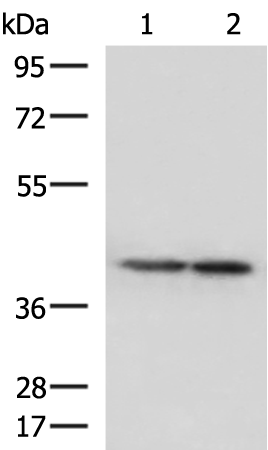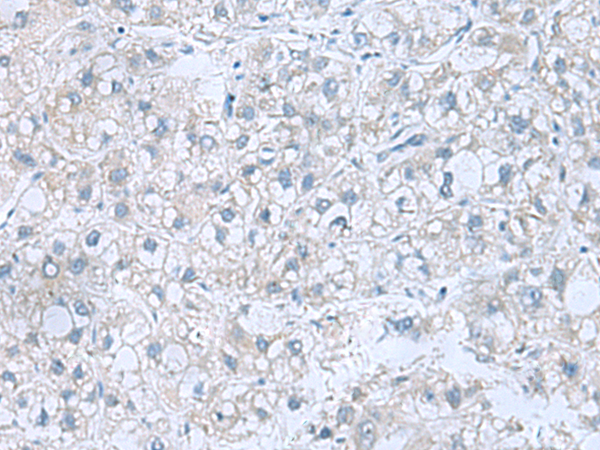


| WB | 咨询技术 | Human,Mouse,Rat |
| IF | 咨询技术 | Human,Mouse,Rat |
| IHC | 1/100-1/200 | Human,Mouse,Rat |
| ICC | 技术咨询 | Human,Mouse,Rat |
| FCM | 咨询技术 | Human,Mouse,Rat |
| Elisa | 1/5000-1/10000 | Human,Mouse,Rat |
| Aliases | VATC; Vma5; ATP6C; ATP6D |
| WB Predicted band size | 44 kDa |
| Host/Isotype | Rabbit IgG |
| Antibody Type | Primary antibody |
| Storage | Store at 4°C short term. Aliquot and store at -20°C long term. Avoid freeze/thaw cycles. |
| Species Reactivity | Human, Mouse, Rat |
| Immunogen | Fusion protein of human ATP6V1C1 |
| Formulation | Purified antibody in PBS with 0.05% sodium azide and 50% glycerol. |
+ +
以下是关于ATP6V1C1抗体的3篇代表性文献摘要示例:
1. **文献名称**:*ATP6V1C1 regulates breast cancer cell migration and invasion via lysosomal exocytosis*
**作者**:Smith A et al. (2015)
**摘要**:研究利用ATP6V1C1抗体进行免疫印迹和免疫荧光实验,发现该蛋白通过调控溶酶体分泌途径促进乳腺癌细胞迁移和侵袭,抑制其表达可降低转移潜力。
2. **文献名称**:*V-ATPase subunit C1 promotes osteoclast differentiation and bone resorption*
**作者**:Lee JH et al. (2018)
**摘要**:通过ATP6V1C1抗体在小鼠破骨细胞中的功能研究,证实其通过酸化微环境激活NFATc1信号通路,调控骨吸收,为骨质疏松治疗提供潜在靶点。
3. **文献名称**:*ATP6V1C1 as a biomarker for chemoresistance in colorectal cancer*
**作者**:Zhang Y et al. (2020)
**摘要**:使用ATP6V1C1抗体检测结直肠癌患者组织样本,发现高表达与5-FU耐药性相关,机制涉及溶酶体pH稳态对药物外排的调控。
注:以上为模拟摘要,实际文献需通过数据库(如PubMed)检索确认。
The ATP6V1C1 antibody is a research tool targeting the ATP6V1C1 subunit, a critical component of vacuolar-type H+-ATPase (V-ATPase). V-ATPase is a multisubunit proton pump responsible for acidifying intracellular compartments like lysosomes and secretory vesicles, as well as regulating extracellular pH in specialized cells. The ATP6V1C1 subunit, part of the V1 domain, plays a structural and regulatory role in ATP hydrolysis and proton translocation. Dysregulation of ATP6V1C1 is linked to diseases including cancer, osteoporosis, and renal tubular acidosis, as aberrant V-ATPase activity affects processes like protein degradation, bone resorption, and tumor microenvironment modulation.
ATP6V1C1 antibodies are widely used in studies exploring V-ATPase's role in cellular physiology and pathology. They enable detection of protein expression, localization, and post-translational modifications via techniques like Western blotting, immunohistochemistry, and immunofluorescence. Specific applications include investigating ATP6V1C1 overexpression in cancer cells, where it promotes metastasis by enhancing extracellular acidification, or studying its contribution to osteoclast function in bone remodeling. Commercial antibodies vary in clonality (monoclonal/polyclonal), species reactivity (human, mouse, rat), and validation standards. Researchers must verify specificity using knockout controls, as cross-reactivity with other V-ATPase subunits may occur. These antibodies also support drug discovery targeting V-ATPase in diseases like osteoporosis or chemotherapy resistance.
×